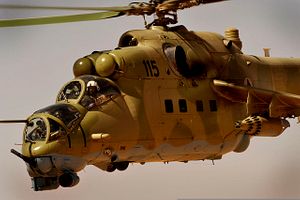As The Diplomat reported on Tuesday, Russia has decided to lift its long-standing, self-imposed embargo on weapons deliveries to Pakistan in an unexpected move. Sergei Chemezov, the head of Russia’s state-owned defense technology corporation Rostec, announced the decision. Chemezov further confirmed that Russia and Pakistan are bilaterally negotiating the sale of Mi-35 Hind attack helicopters.
The move is a surprising paradigm shift in Russian policy. The obvious question most commentators have already raised is the prospect of this decision upsetting India. According to the Stockholm International Peace Research Institute (SIPRI), India, the world’s largest defense equipment importer by a long shot, relied on Russia for over 75 percent of all of its imported weaponry in the 2009-13 period. With that sort of dependence on Russian weaponry, even if India were to be antagonized by Russia reversing its embargo on Pakistan, there is likely little New Delhi could do to exert leverage on Moscow to prevent this deal. Despite the reasons for India to be apprehensive about this development in Russia-Pakistan relations, it is likely that Moscow at least consulted New Delhi about the prospect of eventually selling arms to Pakistan. Even if this wasn’t the case, consultations between Pakistan and Russia have been taking place for some time now as relations between those two countries have slowly grown warmer.
Relations between Russia and Pakistan, of course, have a storied history going back to the Cold War, including the relative antagonism between NATO-aligned Pakistan and the Soviet Union. Following the Indo-Soviet pact of 1971 and the India-Pakistan War that same year that resulted in the independence of Bangladesh, Pakistan’s military grew particularly skeptical of Soviet intentions for South Asia. This skepticism intensified during Zia ul-Haq’s military dictatorship in the 1980s as the Soviets carried out their campaign in Afghanistan. Following the collapse of the Soviet Union, relations between contemporary Russia and Pakistan normalized and began to warm in the 1990s.
For Russia, Afghanistan’s fate is inextricably linked to Pakistan and its policy towards that country. While Pakistan’s military establishment strives to convert Afghanistan into a weak client state, the Kremlin likely sees proximity with Pakistan’s civilian government as opportune as NATO prepares to withdraw from the country at the end of this year. As Zach briefly outlined in his report, lifting the arms embargo will not only bring the two countries together but also serves Russia’s national interest in terms of making Afghanistan and Central Asia more generally less hospitable to Islamic terrorism. The Mi-35 negotiations support this hypothesis as they could be used by Pakistan’s military in its domestic fight against the Taliban.
Lifting the arms embargo thus allows the Kremlin to play a positive sum game in South Asia without significantly threatening its important relationship with India. The decision to lift the arms embargo may also likely be motivated by India’s election of Narendra Modi, who has said that he would focus on reducing India’s reliance on imports. Even a modest reduction in Indian demand for Russian hardware could be problematic for Russia, hence the need for alternate markets.
Beyond South Asia, broader geopolitical dynamics may have also pushed the Kremlin’s hand in lifting the arms embargo. Most notably, the deal comes as Russia’s relations with the West are at an all-time post-Cold War low owing to Russia’s recent actions in Ukraine and its insistence on supporting Bashar al-Assad’s regime in Syria. The latter conflict may have influenced Moscow’s decision more than some might admit. One of Moscow’s primary anxieties in the Syrian conflict has been the prospect of losing Bashar al-Assad not only as an important strategic partner in the region — granting Moscow access to the Mediterranean — but losing al-Assad as a weapons customer. Given the al-Assad government’s inability to pay for weapons, Russia has been forced to tolerate a non-profitable state of affairs. While losing Syria as a customer wouldn’t crush Russia’s defense industry, opening up access to Pakistan hedges losses in Syria and elsewhere.
One final point worth mentioning is that the deal could be intended to lower the incentives for Pakistan to pursue its own indigenous manufacturing projects that could compete with Russian offerings. One notable example is the JF-17 Thunder (also known as the FC-1 Xiaolong in China) multirole fighter which Pakistan is jointly developing with China. While the JF-17 is being manufactured in relatively modest numbers compared to similar Russian offerings, Pakistan allegedly has a wide range of interested customers (although it hasn’t finalized any deals yet). By granting Pakistan direct access to aircraft of a comparable cost without the high fixed costs of investing in domestic manufacturing, Moscow could maintain its competitive advantage in the global defense market.
Overall, the Kremlin had good reasons to lift its self-imposed embargo on arms exports to Pakistan and stands to reap a wide range of benefits. One shouldn’t overplay the negative impact this might have on Russo-Indian ties, which will likely continue to remain strong even as New Delhi bolsters its indigenous manufacturing capabilities and diversifies its import sources to include Israel, France, Britain and the United States.

































